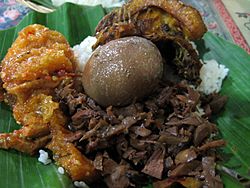Gudeg facts for kids

A typical serving of gudeg.
|
|
| Course | Main course |
|---|---|
| Place of origin | Indonesia |
| Region or state | Yogyakarta, Central Java |
| Serving temperature | Hot or room temperature |
| Main ingredients | Young jackfruit, coconut milk, palm sugar, chili, various spices, chicken, egg, tempeh (optional) |
| Variations | Dry gudeg, Solo gudeg, Gudeg Putih |
Gudeg is a super yummy traditional dish from Indonesia. It comes from places like Yogyakarta and Central Java. Imagine a sweet stew made from young, unripe jackfruit. This special fruit is cooked for many hours. It gets its sweet taste from palm sugar and its creamy texture from coconut milk.
Other spices like garlic, candlenut, coriander seeds, and galangal are added. Bay leaves and teak leaves also go into the mix. The teak leaves give gudeg its famous reddish-brown color. Many people call it "green jackfruit sweet stew."
Contents
What is Gudeg Made Of?
Gudeg is mainly made from young jackfruit and coconut milk. This means it can be a great vegetarian meal on its own. But usually, people add other tasty things to it.
How is Gudeg Served?
Gudeg is often served with warm white rice. You can also have it with chicken, prepared in different ways. Sometimes it's opor ayam, which is chicken cooked in coconut milk. Other times, it's ayam goreng, or fried chicken.
You might also find gudeg served with eggs. These can be telur pindang (marbled eggs) or just plain hard-boiled eggs. Tofu and tempeh are common additions too. A spicy stew called sambel goreng krechek is often served alongside. This stew is made from crispy beef skins.
Different Kinds of Gudeg
There are a few different styles of gudeg. Each one has its own special touch!
Dry Gudeg
This type of gudeg has very little sauce. It's cooked until most of the coconut milk has been absorbed. This makes it a bit drier and easier to pack.
Wet Gudeg
Wet gudeg has more coconut milk. This means it has more sauce, making it a bit soupier.
Yogyakarta Style Gudeg
The most famous gudeg comes from Yogyakarta. It is usually sweeter and drier. It also has a reddish color. This color comes from the teak leaves used during cooking. People often call this "red gudeg."
Solo Style Gudeg
Gudeg from the city of Surakarta (also known as Solo) is different. It's more watery and has lots of coconut milk. It's also whitish in color because teak leaves are usually not added. This is why it's sometimes called "white gudeg."
East Javanese Style Gudeg
This version of gudeg is spicier than the Yogyakarta style. If you like a little heat, this one might be for you!
Yogyakarta is very famous for its gudeg. In fact, the city is sometimes called "Kota Gudeg," which means "City of Gudeg." You can find many gudeg restaurants in the Wijilan area of Yogyakarta. This area is near the Sultan's palace.
How Gudeg is Packaged
Gudeg can be packed in different ways for you to take home. It can come in a besek, which is a box made from bamboo. It can also be put into a kendil, which is a clay jar.
Did you know that gudeg can even be canned? Canned gudeg can stay fresh for up to a whole year!
You can find warung (small food stalls) and restaurants selling gudeg all over Indonesian cities. It's a very popular dish, even in nearby countries like Singapore.
See also
 In Spanish: Gudeg para niños
In Spanish: Gudeg para niños


